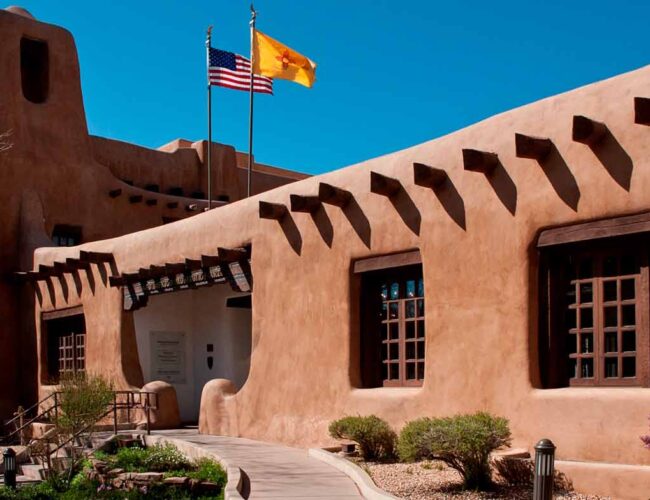Some of the Great Potters
I Have Known: Maria Martinez
BY FRANCES H. HARLOW
The pueblo nearest Los Alamos is San Ildefonso. First occupied in the 1300s, the village is situated north of the highway linking Los Alamos and Pojoaque. There is a large open plaza with a circular kiva in the center. Enormous cottonwood trees flank some of the adobe houses facing the plaza, where ceremonial dances take place.
The pueblo—and its potters—became world famous in the 1920s for their stunning, lustrous black pottery. The most prominent among the potters was Maria Martinez. She and her husband, Julian, are credited with reviving an ancient black pottery style made by their ancestors, in addition to developing a method for decorating it with matte black designs. . . . My strongest impression of Maria was of her lovely character. We first met in 1961 when our whole family (Pat and I and our four kids) went to the Indian crafts store on the west side of the plaza. In those days, there were still many traditional adobe homes around the plaza. Some of the house blocks were busily occupied, while others were abandoned and starting to return to the earth. . . . We met Maria’s son Tony and his wife, Anita, in the store. At that time, Tony mostly was known by his Indian name, Popovi Da, or Po for short. We may have telephoned ahead of time to express our interest in meeting Po’s mother, or we may have arrived without a prior appointment. In any case, our expression of interest in meeting Maria resulted in Po’s leaving us with Anita while he went to get his mother. When she came into the room to meet us, her expression was gracious and friendly, but she seemed rather formal in her demeanor. She responded in her Tewa language to our expressions of pleasure at meeting her, which Po translated.
I later found where Maria was living—in a little detached adobe house on the east side of the plaza, and one day I decided to knock on the door to see if she was there. She was, and that was the beginning of a wonderful friendship. The first thing I learned was that she spoke English very well but that when Po or some other member of the family was present, it was customary for her to speak with a visitor in her Tewa language and then be translated by someone else. When she and I were together by ourselves, our conversations were very lively and friendly, and I came to realize what a wonderful lady she was. . . .
I witnessed for myself Alice Marriott’s observation (in her book María: The Potter of San Ildefonso) that Maria loved to please people; they were especially delighted whenever Maria said that a pot they had brought was, indeed, made by her. The trouble is that there is clear evidence that she was not the maker of some of them. It took a number of visits with Maria to convince her that I was eager for her accurate opinion rather than what she thought I wanted to hear. After we reached that understanding, Maria was very helpful in explaining how she really decided whether or not she made a pot. The two principal criteria had to do with the form of the vessel and the designs used in the decoration. In assessing the origin of a pot, she felt down inside “to see how it curves,” and she looked at the exterior contours to see the perfection of balance and form that characterize her vessels, especially jars. Regarding the designs, Maria was very open in her statement that she never painted decorations, relying instead on her husband, Julian, and other relatives and friends. She characterized the design features painted by each of these people quite consistently and said that the design was especially important in assessing whether she was the maker of a pot. Her assessment depended on her ability to recognize who the painter was.
One pot that I took for her to identify especially delighted her. “That was made by Martina and Florentino Montoya,” she said, and she added with genuine conviction, “They were the best of all the San Ildefonso potters!”
Excerpted from Adventures in Physics and Pueblo Pottery: Memoirs of a Los Alamos Scientist, by Francis H. Harlow with Dwight P. Lanmon. Museum of New Mexico Press, 2016. 204 pages, 24 black-and-white and 71 color illustrations, $34.95 hardcover.

